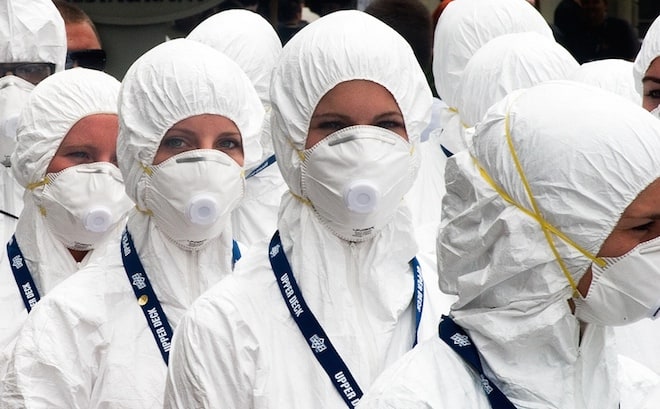
Jason Scragz (CC), Flickr
A paper published this week reminded me to take a fresh look at NDM, the “Indian superbug” — actually a gene and enzyme — that got so much attention, including from me, in 2011. (Most of the posts are here.) Quick reminder: NDM surfaced in 2008 in Sweden, then was found in the United Kingdom, then in the United States and then elsewhere in the world. It had several distinctive qualities. It appeared in gut bacteria such as Klebsiella and E. coli, and caused infections when those bacteria escaped the gut and got elsewhere in the body. It rendered those bacteria not-vulnerable to almost all antibiotics, leaving so few drugs to use against it that medical personnel found it truly alarming. And it had strong links to South Asia: The first known patient was an Indian man living in Sweden who had gone home for a visit and been hospitalized; victims found later either had family links to India and Pakistan or had gotten medical care there, as medical tourists or because they were injured while traveling.
NDM (which stands for New Delhi metallo-beta-lactamase; it was originally NDM-1, but there are now at least seven variants) generated a lot of alarm at the time, with good reason. Its unusual resistance pattern made useless the last category of broad-spectrum, last-resort antibiotics, called carbapenems, that were still working reliably. Physicians treating patients who had infections involving NDM had to hunt among just a few remaining drugs that were still on the shelf because they were toxic or did not work reliably. Plus, because bacteria carrying the NDM resistance factor colonize the gut, the infection could be transported across borders and into hospitals without anyone noticing. With no symptoms showing, few hospitals would bother to check a patient (or a family member), especially since testing for gut bacteria is more complicated and intimate than, for instance, testing someone’s nostrils for MRSA.
By last year, NDM had mostly dropped out of the headlines, even though it was still moving across the globe (this 2013 paper details countries where it has been identified), and had also begun causing hospital outbreaks (for instance, this one in Denver in 2012). So the new paper I mentioned, written by staff from Public Health England and analyzing the first 250 patients with NDM in the UK, is a useful reminder of how formidable a microbiologic foe this can be.
Here’s the most important take-away: The 326 clinical isolates (from 250 patients) were overwhelmingly resistant to carbapenems; most were also resistant to aminoglycosides, aztreonam, and ciprofloxacin. The only compounds to which a majority of isolates responded were the decades-old drug colistin (90 percent) and the newer one tigecycline (57 percent). From the paper:
…colistin use may lead to development of resistance during therapy and is potentially nephrotoxic and neurotoxic. Tigecycline is licensed for complicated abdominal and skin and soft tissue infections and may not be a suitable agent for treating urinary tract infections owing to low urinary concentrations. In this report, all isolates obtained from primary care settings were urinary, posing a therapeutic challenge.
So, that’s not good.
Some demographic details of the patients:
- 61 percent were male and 58 percent were older than 60
- They came from throughout the UK: England (233), Scotland (7), Wales (4) and Northern Ireland (6)
- Within England, they were distributed throughout the country: with the largest number in London (88), followed by the West Midlands (39), Greater Manchester (23) and Yorkshire and Humber (21)
- Most (82 percent) had been hospitalized, but in 12 percent NDM-carrying bacteria were detected in primary care visits
- Whether or not the patient had traveled could be determined for only 40 percent of them — but among those 101, 41 had not left the UK.
Most of those details are merely interesting, but the last two are unnerving. It suggests — the authors say this also — that NDM is achieving local spread, and may be becoming a community organism as well as a hospital one. That means it is going to continue to show up unpredictably, and will likely force hospitals into scrupulous (and therefore expensive) patient-testing and ward-cleaning regimes.
Public Health England released a press release this week about the study, which is not shy about stressing that NDM travels in gut bacteria that escape the body via feces: “These gut bacteria can spread between people by the faecal-oral route, where the microscopic bacteria are transferred from the hands to the mouth. This can occur, for example, when people do not wash their hands properly after using the toilet.”
The release quotes Anthony Kessel, director of public health strategy at Public Health England:
The results of this study are a stark reminder of the issue that we are facing with the growing problem of antibiotic resistance. Having only one antibiotic available for treating patients with this resistance mechanism and limited effectiveness with a further three represents a great challenge for the future of healthcare as we know it.
Cite: Jain A, Hopkins K, Turton J et al. NDM carbapenemases in the United Kingdom: an analysis of the first 250 cases. J. Antimicrob. Chemother. first published online April 25, 2014 doi:10.1093/jac/dku084